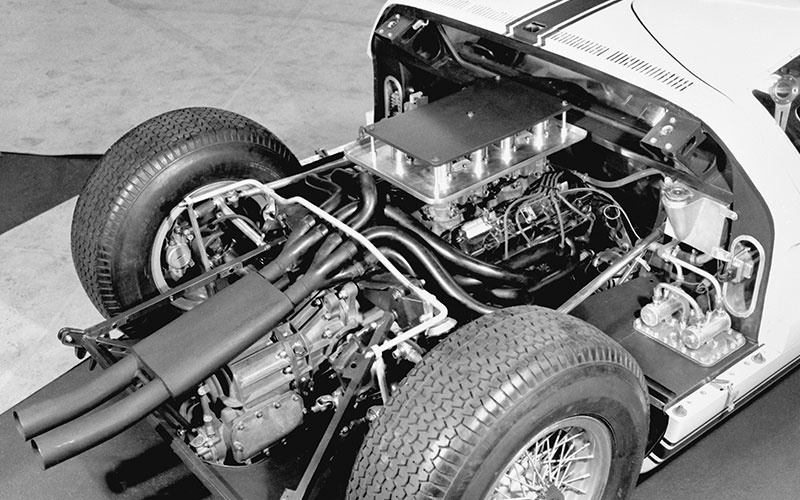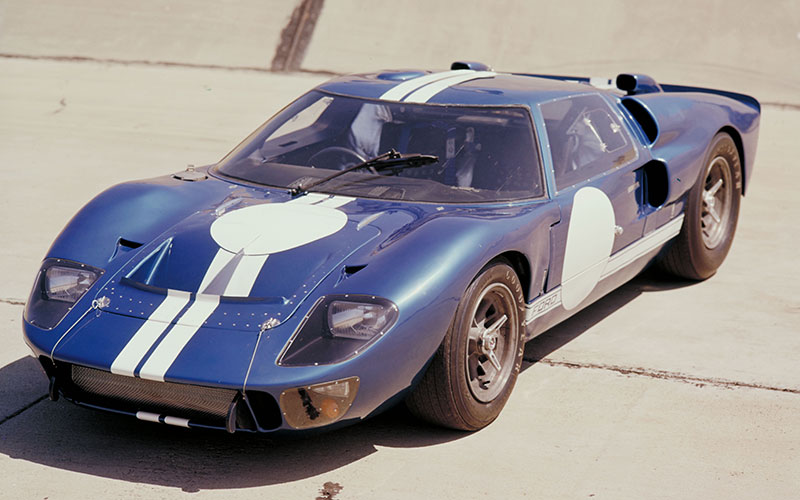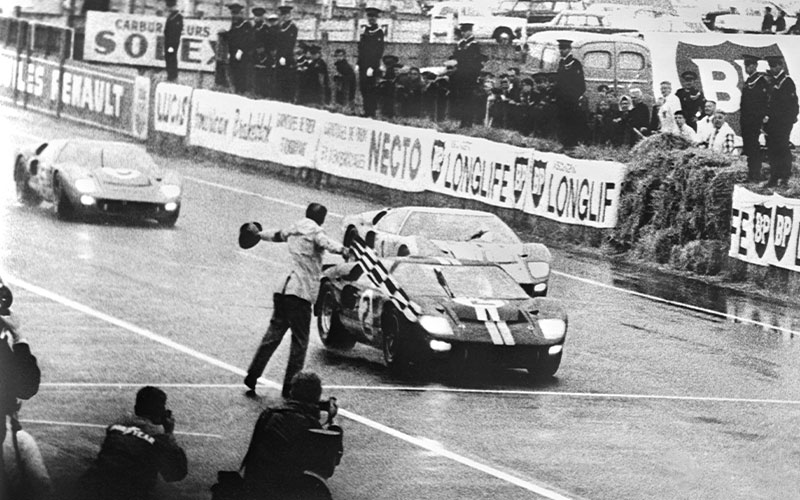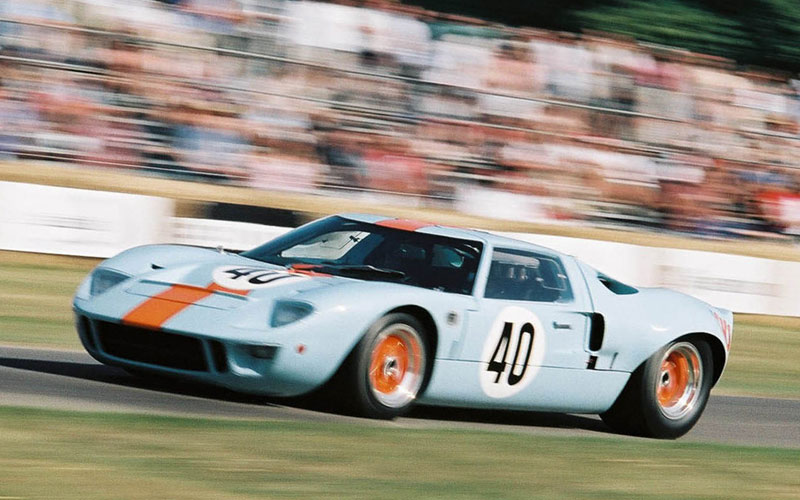Retro Review: Ford GT40
The Ford GT40 was born of a grudge with Ferrari, went on to dominate at Le Mans, and go down as one of the greatest racecars in history.
Ford GT40 = G.O.A.T.?

Ford GT40 – netcarshow.com | Shop Ford GT40 on Carsforsale.com
The Ford GT40 just might be the greatest Ford ever built. Sure, the Model T was more influential, and the Mustang more beloved, but when it comes to performance, in its day the Ford GT40 was incredible. Its tale of racing glory is one of the most famed in all automotive and racing history. With loads of high drama and a cast of colorful characters, the story of the GT40 was so compelling they made a movie about it.
Ford vs. Ferrari

In the early 1960s, Ferrari was a dominant force in GT racing. The Ferrari 250 GTO was winning race after race, quickly etching its name into the pantheon of all-time greats. Meanwhile, Ford had been on the sidelines along with the rest of Detroit as part of the AMA (Automobile Manufacturers Association) ban on racing. But, in a bid to keep Ford competitive in the marketplace, Henry Ford II decided to get back into racing. Not only would Ford again participate in stock car racing, “Hank the Deuce” set his sights on European GT racing.
Rather than build a GT racing program from the ground up, Ford looked to buy into one. Top of the list was Ferrari. Though Ferrari had been consistently competitive on the track, Enzo Ferrari’s company had long been building road cars to pay for its racing division. Racing prestige, it turned out, wasn’t enough to keep the lights on at Maranello and Ferrari’s finances had become increasingly precarious. So, when Henry Ford II and company swooped in with an offer to buy Ferrari, the deal looked logical enough, at least on paper.

A major sticking point quickly emerged. Though Enzo Ferrari would retain nominal control of the racing division, Scuderia Ferrari, its budget would be tightly limited by Ford. Additionally, Ferrari would bow out of the Indy 500, as Ford was fielding its own engine in the race. Enzo Ferrari, the racing die-hard, could not brook such compromises and summarily cut off negotiations. Henry Ford II was not pleased. He vowed to beat Ferrari at their own game, on their own turf, at the 24 Hours of Le Mans.
Early Struggles

With near unlimited resources, a team at Ford was gathered to develop a new GT car. The team was headed by Harley Copp along with John Wyer, former Aston Martin team manager, Ford engineer Roy Lunn and Eric Broadley of Lola a British engineering company. As part of Broadley’s contract, he supplied two Lola GT chassis as the basis for the new car.
Using the Lola chassis as a starting point, Lunn, Wyer, and Broadley began work at the Lola factory before moving to Slough, outside London. The GT40’s initial engine was a 289 cu.-in. Fairlane DOHC V8 sending power to a manual five-speed. The name GT40 combined Grand Touring with the car’s height, a modest 40 inches.

The first series of races for the Ford GT40 produced underwhelming results. The GT40’s first race in May of 1964 at the Nürburgring saw the GT40 suffer a suspension failure. The first attempt at the 24 Hours of Le Mans was abysmal, with all three cars failing to finish. The lackluster performance led to a shift from John Wyer to Wyer’s former Aston Martin driver and Le Mans winner, Carroll Shelby.
Shelby and Le Mans

The first order of business for Shelby and his team at Shelby American was to rework the GT40. The GT40 underwent extensive revisions to its aerodynamics, suspension tuning, and exhaust. Steel parts were traded out for lighter-weight aluminum.
The work began to pay off in 1965 as the GT40 Mk II took first and third on its return in the Daytona 2,000km. This was followed by a second place showing at the 12 Hours of Sebring. For Le Mans, Shelby had found a new engine, the same Ford 427 V8 he’d been using in the Shelby Cobra, along with a new four-speed ZF transmission. Two GT40s raced with the new engine while three others kept the smaller 289. All five cars failed to finish. Meanwhile Ferrari claimed another victory at Le Mans, their sixth in a row.

Testing and refining continued on the GT40 for the 1966 season, with Ken Miles and Phil Hill racing and tweaking the cars to eke out every ounce of performance. The 1966 season was where the GT40 came into its own. A 1, 2, 3 finish at the Daytona 24 Hours was followed by a 1, 2, 3 finish at the 12 Hours of Sebring. In that race, Dan Gurney’s car was in the lead with a hundred yards to go when it threw a rod. Gurney famously pushed his car over the finish line. This prompted further work on the 427 for stamina. The engine was tested to a dyno run of 48 hours, double the requisite race time.
1966 24 Hours of Le Mans

The 1966 24 Hours of Le Mans was where the GT40 cemented its place in racing and automotive history. The Ford cars kept pace with their Ferrari rivals through the initial stages of the race (Ferrari fielding 330P3s and 385P2s). Rain and the rigors of the race eventually forced all of Ferrari’s cars from competition, leading to a 1, 2, 3 finish for Ford. Henry Ford II had his Ford victory over Ferrari.
The win was not without its controversy. Ford had wanted a three-way photo finish for the press. The ACO initially had indicated that this would be allowed, but upon review, the officials found that Bruce McLaren’s car had started eight meters further back from the other Ford cars, and thus would have traveled further in the event of a “tie,” resulting in his first-place finish despite Ken Miles current lead. Ford’s Leo Beebe demurred on altering the drivers and the three-way photo finish saw McLaren and Chris Amon given first place. Miles played off his disappointment, saying he worked for Ford first and foremost, but he’d just missed out on being the first driver to win Daytona, Sebring, and Le Mans in the same season.
Return of the Mk I GT40

Sadly, Ken Miles died two months later while testing an updated version of the GT40, the J-car which featured new aerodynamics and a new chassis design. The crash called Ford back to the drawing board. The new Mk IV GT40 would be powered by the same 427 V8 but on a new chassis and with new aero. For 1967, the GT40 Mk IV took Sebring again, with Mario Andretti and Bruce McLaren driving, and Le Mans as well, this time with Dan Gurney and AJ Foyt behind the wheel.
John Wyer got another crack at the GT40 in 1968. His team took a modified Mk I GT40 running a 302 Ford Winsor to victory at Le Mans and again in 1969, this time beating out the highly competitive Porsche 908 and the then new Porsche 917 for the prize.

2002 Ford GT40 concept – media.ford.com | Shop Ford GT40 on Carsforsale.com
The Ford GT40 more than met the expectations of Henry Ford II, winning Le Mans four straight years. Decades later, Ford would honor the GT40 with a new version and Ford’s only real supercar, the Ford GT. Why the GT rather than the GT40? Ford had never bothered to trademark the name. By the time they got around to bringing the car back in the early 2000s, someone else held the rights. Even without the name, the Ford GT more than honored the original, but that’s a story for another article.








